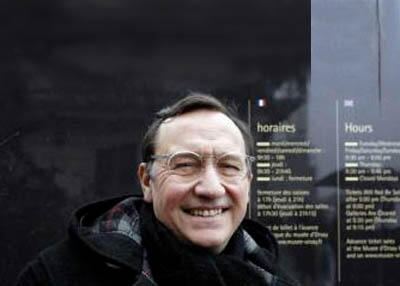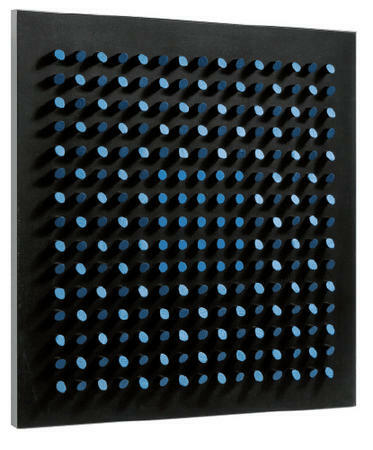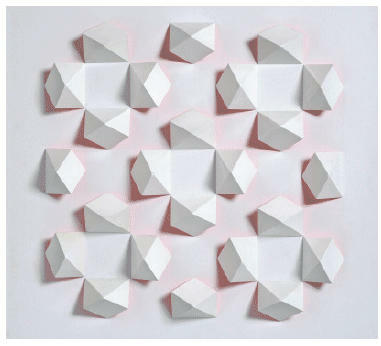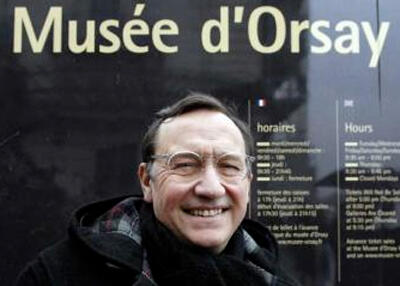Conversation with Serge Lemoine on Luis Tomasello
The exhibition Tomasello. Visible Structure and Reflected Color, organized by Ascaso Gallery in Miami, showcased the work of this master who expanded the view and the possibilities of lumino-kineticism, under the curatorship of Serge Lemoine, Professor Emeritus of Art History at the Sorbonne University, Paris, a theoretician in the field of geometric abstraction and concrete art, and the author of revealing texts such as Mondrian et De Stijl, or François Morellet, or Aurélie Nemours.

In his essay for the catalogue that accompanies the exhibit, Lemoine highlights the particular relation that Tomasello − whom he calls “a magician of light” and “a master of relief”− has with light. “He does not depict or record light: instead he uses light itself as sculptors or architects do.”
Arte al Día International interviewed Lemoine, who besides having been the Director of the Musée de Grenoble and the Musée d'Orsay, where in 2003 he was responsible for the organization of “Aux origines de l’abstraction”, was the curator of “Art Concret” (Espace de l’art concret, Mouans-Sartoux, France, 2000), and is currently preparing an exhibition which will be held in 2013 at the Grand Palais in Paris: “Lumineux ! Dynamique ! Espace et vision dans l’art de nos jours à 1913” (Luminous ! Dynamic! Space and vision in the art of our days until 1913).
AH: Why, in your opinion, did Latin American geometric and concrete abstraction take root in Paris and were instead disregarded in New York?
SL: It is an interesting question. The United States shut itself up within its frontiers; it focused on the emergence of an art movement which was, for the first time, specifically American: abstract expressionism.
AH: But the genesis of this movement, in turn, lies in the Latin American artist Roberto Matta, who had a decisive influence on Arshile Gorky and De Kooning…
SL: This is undoubtedly so, but Roberto Matta, in turn, had had his artistic training in Paris, and the same can be said of Joaquín Torres García, who had such a strong influence when he returned to Uruguay, where he founded the School of the South after having lived in Paris and created in that city in 1929, together with Michel Seuphor and Pierre Daura, the Cercle et Carré group, which was directly related to Piet Mondrian and Theo van Doesburg. In terms of its origin, abstraction is the same thing in Latin America and in France: Montevideo and Buenos Aires are European-like cities as a result of the migratory currents from the Old Continent, while it is true that Torres García promoted awareness, in his constructivism, of distinctive elements such as the color of the Río de la Plata. This relationship between the South and Paris dates back even to the influence of academic ateliers and of the salons of the end of the 19th century presided over by Pierre Puvis de Chavannes (the master of Argentine artist Eduardo Sívori, who would become the director of the National Museum of Fine Arts). In Tomasello’s case, his residence in Paris, where he settled in 1957, was also determining. It was after his first trip that he founded the Movimiento de Arte Nuevo (New Art Association) in Buenos Aires, aligning with abstraction. And his relationship with Mondrian was decisive for the creation of his work.
AH: Did you meet Tomasello at Denise René gallery around 1962?
SL: I met him some years earlier, because Tomasello formed part of a great movement that converged in Paris and drew on the same sources. I saw him at different exhibitions and visited his studio, as well as that of the influential Jean Gorin and those of other artists of different provenance who explored concrete art and who also used relief to recreate depth on the flat surfaces and imbue them with life. Tomasello creates an oeuvre which, based on limited elements and identical structures and characterized by its regularity, achieves an extraordinarily rich language thanks to the combination of relief and the unique utilization of natural light, which reflects the hidden color upon the surface, creating a virtual lumino-kinetic experience. Relief allowed him to move out into space, to play with light in such a way that the color he applies to the sides of the shapes hidden from frontal view spread over the ground, creating chromatic, luminous halos that he entitles chromoplastic atmospheres.
AH: What is, in your view, Tomasello’s relationship with minimalism?
SL: Minimalists are people who simplified painting. Barnett Newman had already rendered painting simpler: few colors, few shapes, and Tomasello − who abided by Mondrian’s principle of using the minimum of resources to produce the maximum results − also simplified by using regular compositions, repeated shapes, without ever resorting to too many colors. Like Carl Andre or Donald Judd, he alternated element-void-element-void. But while the minimalist system is stable, Tomasello generates a movement associated to the way in which it is perceived. His structures create a virtual kineticism whose genesis is luminic. With nothing but natural light and shadows reflected onto the surface of the work, he creates a universe in motion.
AH: What is your opinion of Tomasello’s lumières noires (black lights) and their relationship with Lucio Fontana?
SL: Viewing an X-ray, which allows us to see things in a different way, or the light in a night club, where shadows magnify the volumes, it is possible to imagine that there also exists a type of black light. In Tomasello’s work there is an extension of the gaze in the black reliefs and in the light that is captured and plays in the slots − which may certainly be associated with Fontana insofar as they attract the gaze to unexpected depths, not in a random way but with the regularity derived from the stability of a structure. At the same time, the natural light projects the black shadows of the reliefs, creating changing perceptions on the surface.
AH: For many artists, geometric abstraction was associated to the utopia not only of a new art alien to the illusion of bourgeois representation but also to the idea of mobilizing a new world.
SL: Utopia and hope are, of course, foundational elements of the modernism originated by the Bauhaus. They are present in the 1919 manifesto of the creation of the Bauhaus in Weimar, launched after World War I. Everyone knows what the Bauhaus sought through the notion of a total work of art. Walter Gropius, Mies van der Rohe, Le Corbusier are utopian: they demand the cathedral of the future, and the artists from all places who adhered to concrete abstraction followed the same path. Gregory Kepes, a Bauhaus artist, noted that the culture needed artists to help convert the world into a human landscape (he feared the loss of balance and aspired to assimilate the scientist’s brain with the poet’s heart and the painter’s eyes). Tomasello establishes a poetics of light that he deposits in the spectator’s perception. But now there is no other utopia than that of painting a picture today and knowing that it is possible to paint another tomorrow. It is there that the utopia resides: in creation; and then he punctually reads the news.
-

Acrylic on wood, 27.5 x 27.5 x 3.5 in.
Acrílico sobre madera, 70 x 70 x 9 cm.
Photograph of the works of Luis Tomasello / Fotografías de las obras de Luis Tomasello © Jean-Louis Losi, Paris -
 Acrylic on wood, 22 x 22 x 3.1 in.
Acrylic on wood, 22 x 22 x 3.1 in.
Acrílico sobre madera, 56 x 56 x 8 cm.
Photograph of the works of Luis Tomasello / Fotografías de las obras de Luis Tomasello © Jean-Louis Losi, Paris -



